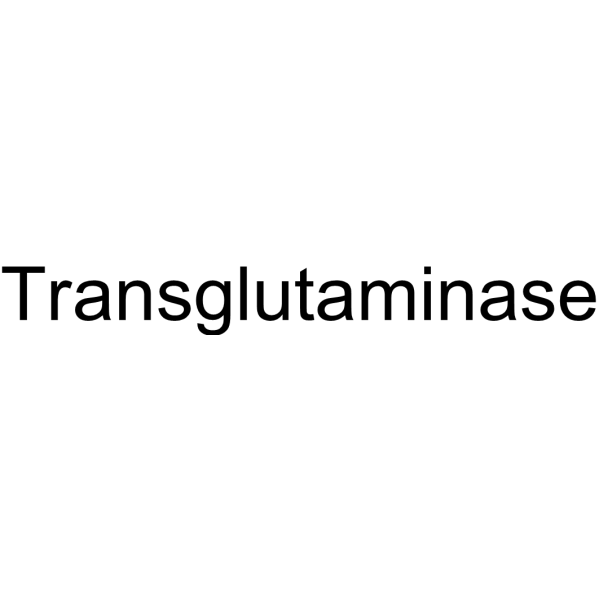Transglutaminase

Transglutaminase structure
|
Common Name | Transglutaminase | ||
|---|---|---|---|---|
| CAS Number | 80146-85-6 | Molecular Weight | N/A | |
| Density | N/A | Boiling Point | N/A | |
| Molecular Formula | C27H44O3H2O | Melting Point | N/A | |
| MSDS | USA | Flash Point | N/A | |
|
Glycation and transglutaminase mediated glycosylation of fish gelatin peptides with glucosamine enhance bioactivity.
Food Chem. 142 , 285-93, (2014) A mixture of novel glycopeptides from glycosylation between cold water fish skin gelatin hydrolysates and glucosamine (GlcN) via transglutaminase (TGase), as well as glycation between fish gelatin hydrolysate and GlcN were identified by their pattern of molec... |
|
|
Inhibition of transglutaminase 2, a novel target for pulmonary fibrosis, by two small electrophilic molecules.
Am. J. Respir. Cell. Mol. Biol. 50(4) , 737-47, (2014) Idiopathic pulmonary fibrosis (IPF) is characterized by progressive fibrotic destruction of normal lung architecture. Due to a lack of effective treatment options, new treatment approaches are needed. We previously identified transglutaminase (TG)2, a multifu... |
|
|
Transglutaminase 2 interacts with syndecan-4 and CD44 at the surface of human macrophages to promote removal of apoptotic cells.
Biochim. Biophys. Acta 1853(1) , 201-12, (2015) Tissue transglutaminase (TG2) is a multifunctional protein cross-linking enzyme that has been implicated in apoptotic cell clearance but is also important in many other cell functions including cell adhesion, migration and monocyte to macrophage differentiati... |
|
|
AKT serine/threonine protein kinase modulates baicalin-triggered autophagy in human bladder cancer T24 cells.
Int. J. Oncol. 42(3) , 993-1000, (2013) Baicalin is one of the major compounds in the traditional Chinese medicinal herb from Scutellaria baicalensis Georgi. We investigated the molecular mechanisms of cell autophagy induced by baicalin in human bladder cancer T24 cells. Baicalin inhibited cell sur... |
|
|
Transglutaminase-2 induces N-cadherin expression in TGF-β1-induced epithelial mesenchymal transition via c-Jun-N-terminal kinase activation by protein phosphatase 2A down-regulation.
Eur. J. Cancer 49(7) , 1692-705, (2013) Epithelial-mesenchymal-transition (EMT) is a key event for tumour cells to initiate metastasis leading to switching of E-cadherin to N-cadherin. Transglutaminase-2 (Tgase-2) expression is increased in TGF-β1-induced EMT in A549 lung cancer cells or other lung... |
|
|
Transglutaminase type 2 in human abdominal aortic aneurysm is a potential factor in the stabilization of extracellular matrix.
J. Vasc. Surg. 57(5) , 1362-70, (2013) The aim of this study was to evaluate transglutaminase type 2 (TG2) expression in human abdominal aortic aneurysm (AAA) tissue and to elucidate a potential role of TG2 in AAA formation. TG2, which is a Ca(2+)-dependent cross-linking enzyme, has been proven im... |
|
|
Cystamine ameliorates ventricular hypertrophy associated with modulation of IL-6-mediated signaling in lupus-prone mice.
Life Sci. 92(12) , 719-26, (2013) The aim of this study is to investigate the protective effects of cystamine on lupus-associated cardiac hypertrophy.Balb/c and lupus-prone NZB/W-F1 mice were individually randomized into sham group (saline, n=16) and cystamine group (n=16). Mice received sali... |
|
|
Pituitary adenylate cyclase-activating polypeptide type 1 receptor (PAC1) gene is suppressed by transglutaminase 2 activation.
J. Biol. Chem. 288(45) , 32720-30, (2013) Pituitary adenylate cyclase-activating polypeptide (PACAP) functions as a neuroprotective factor through the PACAP type 1 receptor, PAC1. In a previous work, we demonstrated that nerve growth factor augmented PAC1 gene expression through the activation of Sp1... |
|
|
Reduced inflammatory threshold indicates skin barrier defect in transglutaminase 3 knockout mice.
J. Invest. Dermatol. 134(1) , 105-11, (2014) Recently, a transglutaminase 3 knockout (TGM3/KO) mouse was generated that showed impaired hair development, but no gross defects in the epidermal barrier, although increased fragility of isolated corneocytes was demonstrated. Here we investigated the functio... |
|
|
Procoagulant platelets form an α-granule protein-covered "cap" on their surface that promotes their attachment to aggregates.
J. Biol. Chem. 288(41) , 29621-32, (2013) Strongly activated "coated" platelets are characterized by increased phosphatidylserine (PS) surface expression, α-granule protein retention, and lack of active integrin αIIbβ3. To study how they are incorporated into thrombi despite a lack of free activated ... |